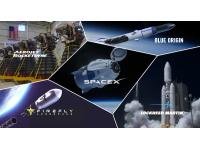October 2024 – The landscape of space exploration has undergone a remarkable transformation in recent years, largely due to the significant contributions from the private sector. Companies like SpaceX, Blue Origin, and Boeing are not only providing launch services but are also driving innovation, reducing costs, and expanding access to space. As national space agencies like NASA and ESA shift their focus toward more ambitious missions, private enterprises are playing a crucial role in shaping the future of space exploration.
The Rise of Commercial Spaceflight
The rise of commercial spaceflight began in earnest in the early 2000s, with entrepreneurs entering the field and challenging the traditional government-led model of space exploration. This shift was catalyzed by the Commercial Crew Program initiated by NASA, which aimed to partner with private companies to develop safe and reliable crew transportation to the International Space Station (ISS). The success of this program has illustrated the potential of public-private partnerships in space.
SpaceX, founded by Elon Musk, has become a leader in this new era of space exploration. Its Falcon 9 rocket has become the workhorse for launching payloads to the ISS and beyond, and the Crew Dragon spacecraft successfully transported astronauts to the ISS, marking the first crewed flight from U.S. soil since the Space Shuttle program ended in 2011. SpaceX is also developing the Starship vehicle, designed for missions to the Moon and Mars, further positioning itself as a key player in deep space exploration.
Innovations in Launch Technology
Private companies are not just launching payloads; they are revolutionizing launch technology itself. Blue Origin, founded by Jeff Bezos, is focused on developing reusable rockets, such as the New Shepard, which successfully completed suborbital flights. This reusable technology reduces costs and increases launch frequency, making space more accessible to various industries, including research, telecommunications, and tourism.
Boeing, a long-standing aerospace manufacturer, is also a crucial player in the commercial space sector. The company’s CST-100 Starliner spacecraft is part of NASA's Commercial Crew Program and is designed to transport astronauts to the ISS. By leveraging its extensive experience in aerospace engineering, Boeing is contributing to the next generation of space transport capabilities.
Supporting NASA and International Collaborations
The private sector's contributions are integral to NASA’s current and future missions. NASA has increasingly turned to private companies to provide services and capabilities that enhance its mission objectives. For instance, the Artemis Program relies on commercial partners for lunar landers, with companies like SpaceX developing the Starship as a lunar lander to facilitate human landings on the Moon.
The Commercial Lunar Payload Services (CLPS) initiative exemplifies NASA’s approach to utilizing private sector capabilities for lunar exploration. Through CLPS, NASA contracts private companies to deliver scientific instruments and technology demonstrations to the lunar surface. This initiative not only accelerates lunar exploration but also encourages innovation among emerging space companies.
New Frontiers: Space Tourism and Asteroid Mining
The private sector is also opening up new frontiers in space exploration. Space tourism is one of the most talked-about developments, with companies like Virgin Galactic and Blue Origin offering suborbital flights for civilians. These ventures are not just about entertainment; they represent a shift in public perception of space and could pave the way for future opportunities in space habitation and research.
Another area where private companies are making strides is asteroid mining. Companies like Planetary Resources and Deep Space Industries are exploring the feasibility of extracting resources from asteroids, potentially providing valuable materials for use in space and on Earth. Although still in its infancy, asteroid mining could revolutionize resource utilization, making space exploration more sustainable.
Challenges and Regulatory Considerations
Despite the many advantages of private sector contributions, challenges remain. The commercial space industry faces regulatory hurdles, including safety standards, environmental concerns, and national security issues. As more private companies enter the space arena, establishing a comprehensive regulatory framework will be crucial to ensure safety and coordination among diverse actors in space.
Additionally, as private enterprises grow, there are concerns about equitable access to space resources and the potential for space debris. Addressing these challenges will require collaboration between governments, regulatory bodies, and private companies to create responsible practices and policies.
The Future of Space Exploration
The private sector's contributions to space exploration are reshaping the landscape, allowing for unprecedented levels of innovation and collaboration. As companies continue to push the boundaries of technology and expand access to space, national space agencies can focus on more ambitious goals, including crewed missions to Mars and the establishment of lunar bases.
As we look ahead, the integration of private and public efforts in space exploration is likely to deepen, opening new avenues for scientific discovery, commercial opportunities, and international collaboration. The future of space exploration is not just in the hands of national governments; it is a shared endeavor that includes the vibrant, dynamic contributions of the private sector. Together, they are forging a path into the cosmos, making the once-unimaginable a reality for generations to come.
FAQs
1. How has the private sector changed space exploration?
The private sector has introduced innovation, competition, and cost reductions in space exploration. Companies like SpaceX and Blue Origin have developed reusable launch systems and advanced spacecraft, allowing for more frequent and affordable access to space, thus enabling new missions and scientific opportunities.
2. What is NASA's Commercial Crew Program?
The Commercial Crew Program is an initiative by NASA to partner with private companies to develop safe and reliable crew transportation systems to the International Space Station (ISS). This program has led to successful crewed flights by SpaceX’s Crew Dragon spacecraft and is paving the way for future human spaceflight missions.
3. What role do private companies play in NASA’s Artemis Program?
Private companies support NASA's Artemis Program by developing technology and providing services necessary for lunar exploration. For example, SpaceX is contracted to provide the lunar lander for Artemis missions, while other companies are involved in lunar cargo delivery through NASA's Commercial Lunar Payload Services (CLPS) initiative.
4. What is space tourism, and which companies are involved?
Space tourism refers to commercial ventures that allow civilians to travel to space for recreational purposes. Companies like Virgin Galactic and Blue Origin are leading the charge, offering suborbital flights to the general public. This emerging market aims to make space accessible to non-professional astronauts.
5. Are there any challenges faced by the private sector in space exploration?
Yes, challenges include regulatory hurdles, safety concerns, high development costs, and competition for resources. As more companies enter the market, establishing a regulatory framework that ensures safety and equitable access to space resources becomes essential to avoid conflicts and promote responsible practices.







